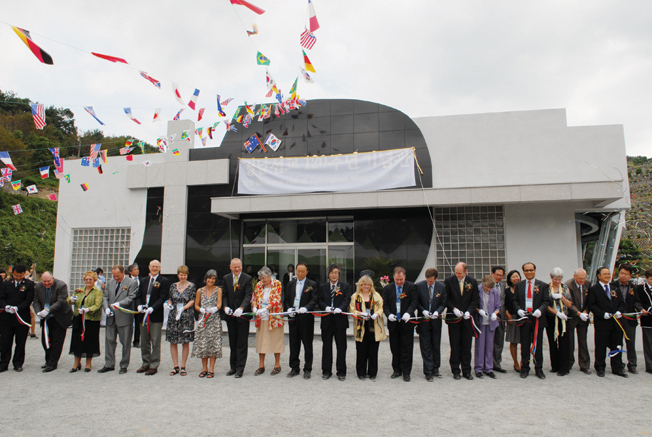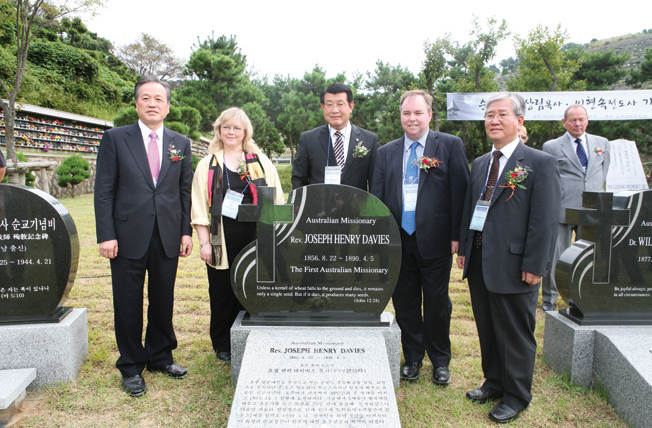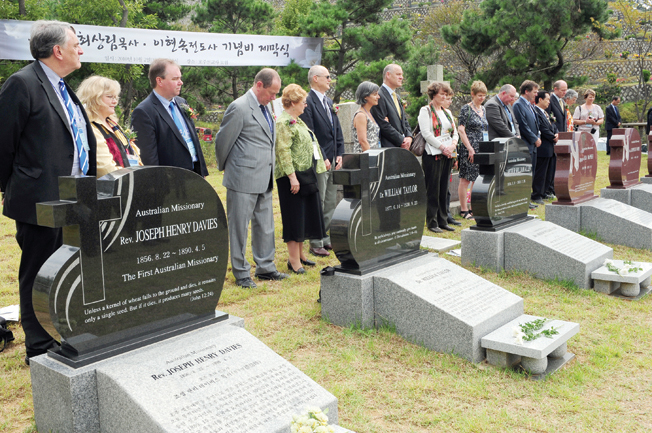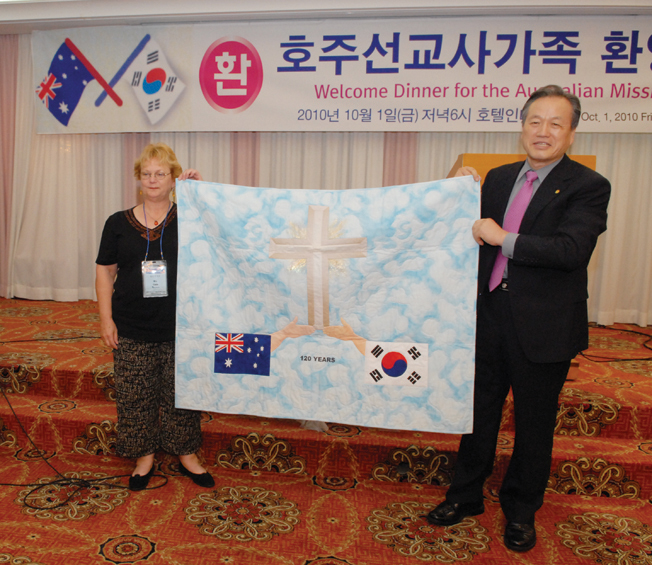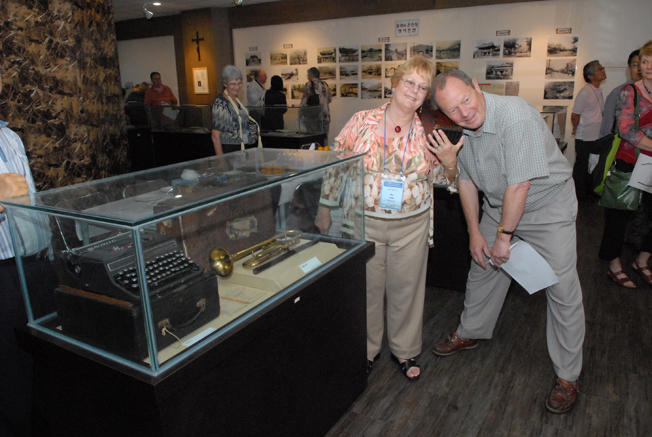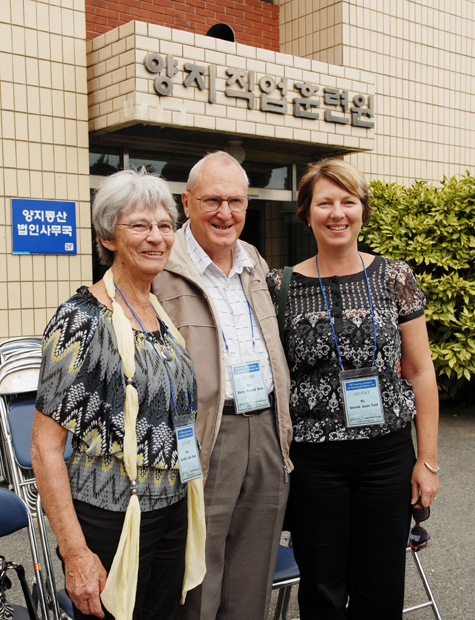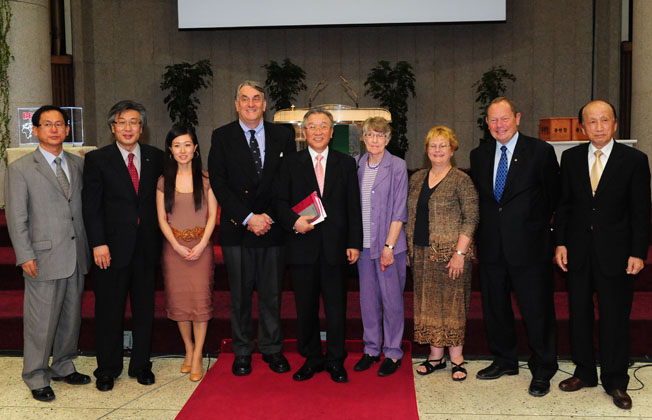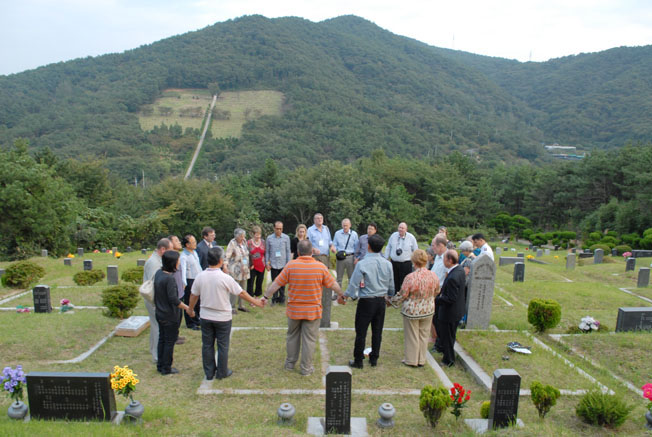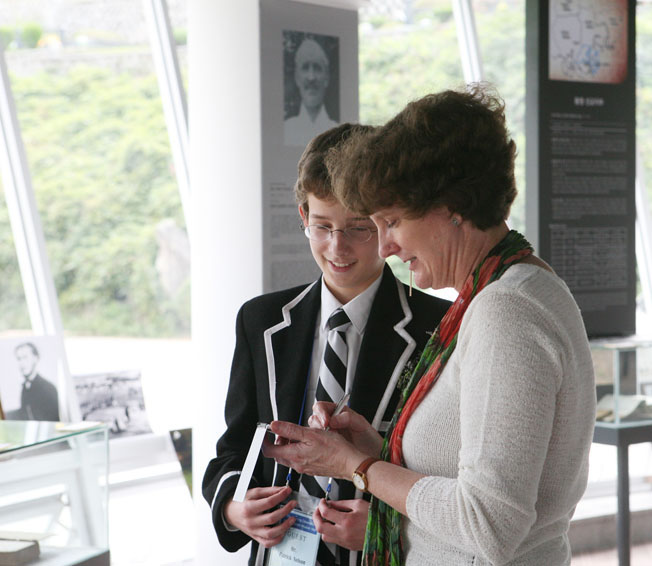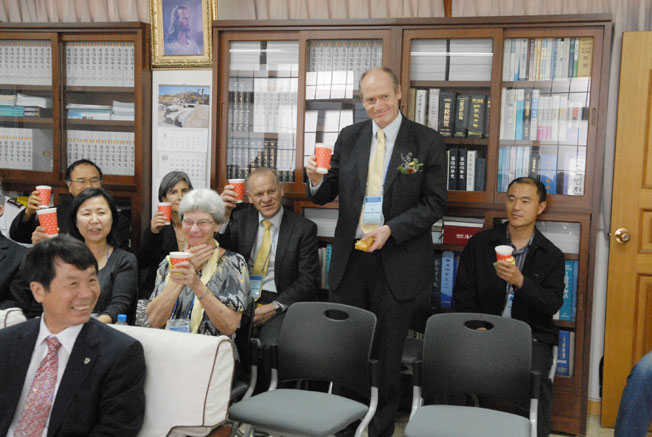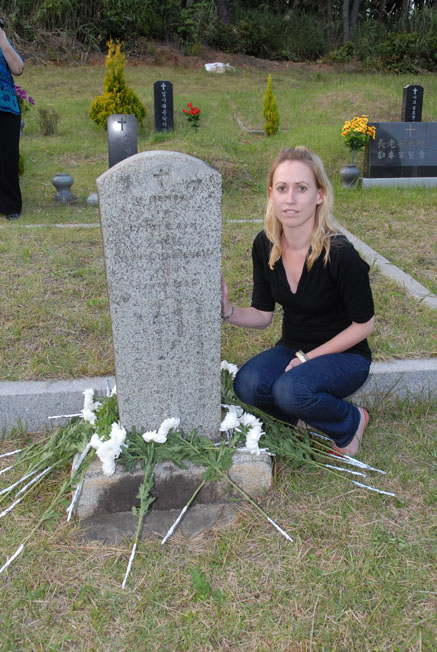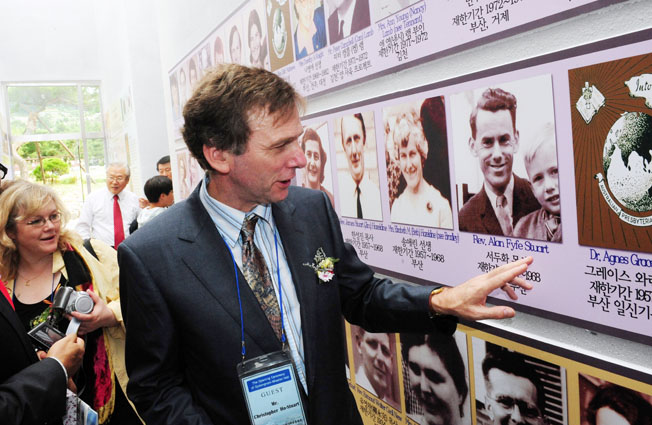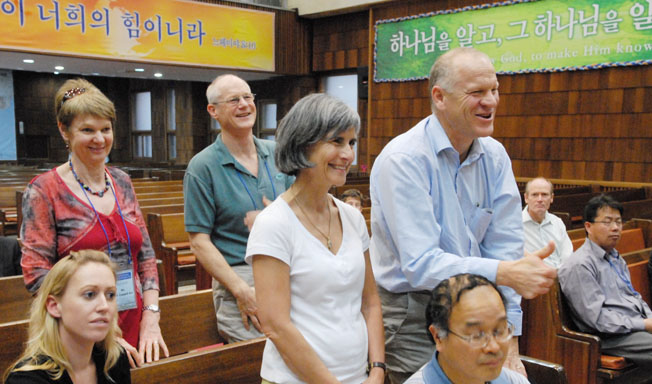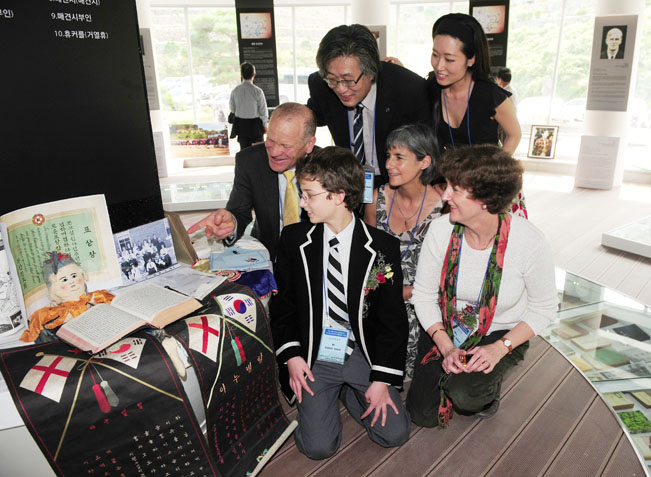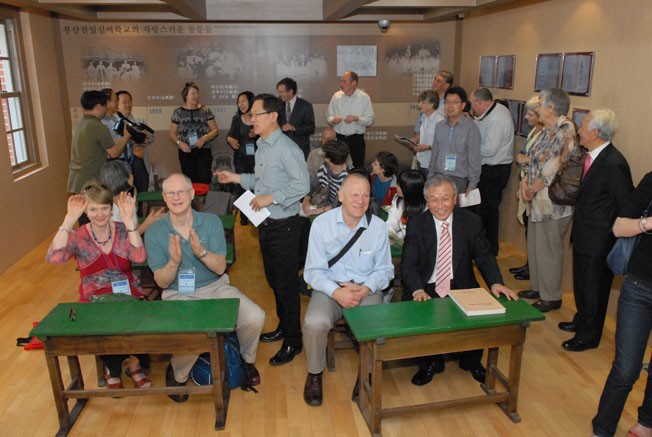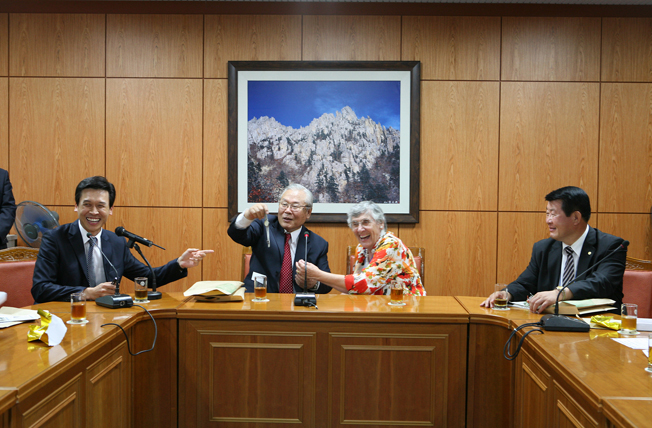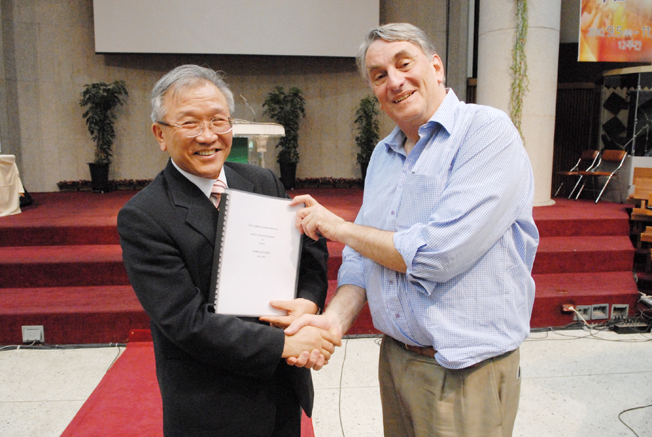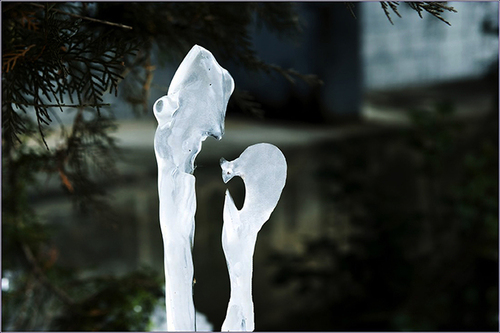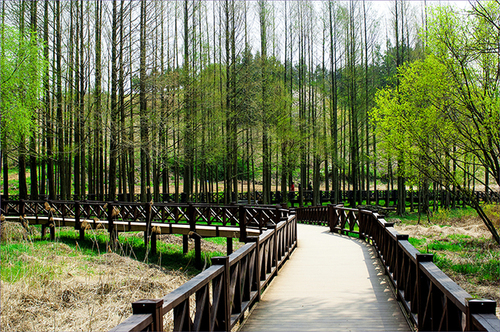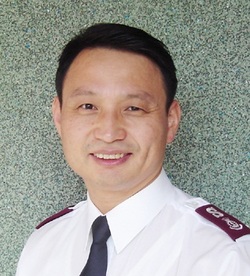Reflections of the Australian missionaries and their descendantsRemembering 120 years of Australian missionaries to KoreaOn 30 September 2010, a group of 21 Australian missionaries and past missionaries’ descendants, as well as 12 Korean-Australians, gathered at Incheon Airport, ready to embark on a 10-day trip in South Korea.
They were the special guests of the Gyeongnam Holy City Movement for the opening of The Memorial Hall of Gyeongnam Mission, to mark the 120th anniversary of Australian missionaries to Korea. Although there were a few missionaries in the group – Barry and Joan Rowe, Barbara Martin and Marjorie Neil – the vast majority were the descendants of past missionaries and hence had limited knowledge of Korea and the contributions their parents, grandparents or great grandparents had made to Korean society. But over the course of the next 10 days, every single member of the group reconnected with their past – they visited the areas where their ancestors had lived and worked, worshipped in churches their forebears had started, paid respects at the gravestones of their family members and delighted in seeing their old photographs and relics displayed in museums. The itinerary included trips to churches, schools, cemeteries, hospitals, museums and memorial halls in Busan, Masan, Changwon and Seoul. All sites had significance to the group as they were either places the Australian missionaries had established or where they’d made great contributions.
The highlight of the trip was the opening of the Gyeongnam memorial hall, which showcased photographs, relics and tributes of the Australian missionaries who had sacrificed and contributed so much to Korean society. It was a moving experience for all, especially as the group laid flowers and paid respects at their ancestors’ newly erected tombstones at Memorial Park, just behind the memorial hall. The book launch of The Fruit of the Australian Missionaries’ Work at the Korean Parliament House was also a big moment, as the publication recognised and recorded the long history and significance of the missionaries’ individual and collective contributions. There were also personal highlights for the each of the group members, such as Barry Rowe revisiting the Yangji Rehabilitation Centre – a school for physically disabled men – which he founded in 1968, and the Gelson grandchildren – Linda Black and David Richards – visiting the Gelson Engel Memorial Hall in Busan. Each group member took away so much from this trip and in the next 10 pages they share with you their personal experiences, thoughts and reflections.
Alison and Douglas Robertson (Representatives of Joseph Henry Davies from Scots Church, Melbourne) When we accepted the invitation to Korea we knew we would be attending a very special opening of the new Gyeongnam Memorial Hall and that we would be sharing the experience with previous missionaries and their families and the descendants of earlier missionaries. However, we were unaware of how deeply touched we would be by the strong connections across the generations, and the generosity and sincere gratitude expressed by the Koreans for the Christian heritage brought to them by the families accompanying us.
Our own connection with the missionary work in Korea came through Joseph Henry Davies, the first missionary from Australiawho went to Korea in 1889. He was ordained and commissioned from Scots’ Church in Melbourne, where my husband Douglas is now the senior minister. Davies spent five months in Korea studying the language, then spent 20 days walking to the Busan area where he was planning to work. He got smallpox and pneumonia on that journey and died the day after he arrived, aged 33 years old. As Davies has no direct descendants of his own, it was a wonderful privilege to have represented him as his Scots’ Church family, and we were very moved as we stood at his grave at the new memorial park and laid flowers there. The itinerary was intense, but fascinating. We visited many churches and were constantly humbled by the work that had gone into preparing for our visit. We were treated to wonderful slideshows and thoroughly enjoyed seeing our companions recognising their relations in old photos, as we learnt about the extent of the work that the Australian missionaries had accomplished in the Busan area. Many of our visits were fairly emotional as we saw the fruits of the labours of the ancestors of our group. It was wonderful to see thriving churches, and hospitals and schools serving the needs of the community and continuing the mission of taking the gospel to the lost and needy. A wonderful finale to the trip was attending the book launch of The Fruit of the Australian Missionaries’ Work at Parliament House in Seoul. The significance of having the descendants of some of those missionaries there was particularly poignant. Our lives are richer for the experience, and our appreciation of the generations who have gone before us has been heightened. What an amazing heritage we have as Christians, and we have so much to thank God for. * For Douglas Robertson’s daily reflections of the trip, visit his blog at: http://kyungnam2010.wordpress.com Linda Black (Granddaughter of Gelson Engel and Agnes Brown) When I first heard that my brother, David Richards, was going to Korea with a group of descendants of various missionaries as the Engel family representative, I was excited for him. It seemed the perfect opportunity to visit the land where our mother, Elsie Engel Richards, was born and raised and where her parents had spent many years of their lives working as missionaries. Our cousin, Margaret Black, had been included, but had to decline for health reasons. That’s when I asked if I might be able join the group as David’s companion. To my delight I was accepted. My focus was on supporting David and sharing the experience with him as a family thing.
However, this focus soon changed after I arrived in Seoul and joined the group. At first I only knew David and Lucy Lane (we visited her and her family when I was young as she and our mother had been close friends). But over the course of the next week this group of strangers became an extended family, sharing family histories, recollections of the old days and, for some, the memories of having grown up in Korea. It was a joy to see Sherrin, Steve, Chris and Michael reconnecting with their shared past and reflecting on their life experiences. It made me realise how my own mother and Lucy must have felt having grown up in Korea, only to then go to a foreign land – Australia – to live. One of the most amazing insights for me was to see how highly respected and venerated my grandparents and the other missionaries are in the eyes of the Korean people of Busan and nearby regions. What a wonderful legacy they have left behind. Their years of missionary work have paid off well, judging by the number of churches and committed Christians that exist today. I was proud to see this and to represent both Agnes Brown and Gelson Engel. I never understood that my grandparents might be thought of as historical figures of importance. Growing up, they were simply grandpa and grandma, who happened to have lived and worked in Korea. By the end of the week I came to more fully understand the repercussions of actions taken, lasting long past one’s own lifetime. One of the highlights was to see the organ and other relics of Gelson Engel and to sing a hymn of praise to music from that organ. It was a reliving of the past with a promise of the future – quite a moving experience. I am proud and humbled to have been included in such a moving and fulfilling experience. David Richards (Grandson of Gelson Engel and Agnes Brown) Thanks to the generosity of the Korean church, my sister, Linda Black, and I were able to visit Korea for the first time. Our grandfather, Reverend Dr. Gelson Engel, with his first wife, Clara (nee Bath), and three young children, landed in Busan 110 years ago. Miss Agnes Brown, our grandmother, had arrived in Korea in 1895 and subsequently married Gelson in 1907, a year after Clara died. Our mother, Elsie Engel, born in 1913, was the third and youngest child of this marriage.
So with great excitement we sought to retrace their footsteps. It was an absolutely unforgettable week in Busan and Seoul, characterised by a warm welcome wherever we went, exceptional hospitality, great organisation and the development of new friendships. As the week unfolded, it was like putting together a jigsaw – each stop there was a new piece to fit into the wider picture. It enabled us to get a better understanding of what it must have been like for our mother to spend the first 19 years of her life in Korea. While we grew up knowing our grandparents had served the churches in Korea for some 40 years, we were truly amazed to see in what high esteem all our ancestors and the more recent missionaries are held by the current generation of Koreans. We are very proud to see the work that has been done to honour the missionaries, from the Gyeongnam mission memorial hall to the Gelson Engel Memorial Hall and other tributes to the past. Barry and Joan Rowe (missionaries to Korea) and Sherrin Ford (daughter of Barry and Joan Rowe) Although we had lived in Korea from the mid-1960s to mid-1970s, we had very little knowledge of the history of the early Australian missionaries to Korea. The respect for, and gratefulness to, these missionaries from the congregations we visited was palpably evident in the gracious and very warm way in which we were treated. What a legacy these early missionaries left to the Korean people, in their setting up of Christian churches, schools and health facilities. But the Koreans did not stand still and leave these beginnings as only beginnings – they have continued and enlarged on the work begun so long ago, from generation to generation.
Although the early Australian missionaries to the Gyeongnam province were sent by the Presbyterian church, we were very impressed to see that the Gyeongnam Holy City Movement is an interdenominational group of Christians who are grateful to God for His love and who want to spread the knowledge of this love in a very visible way with the building of the Gyeongnam memorial hall in such impressive and beautiful surroundings. A special memory for us was to see the warmth that the Korean Christian ministers shared with each other and with others – the warmth of handshakes, broad smiles, laughter and physical touching. It was a different picture from the memories of the 1960s when the ministers were solemn and sombre, when perhaps more emphasis was on the teachings of the Old Testament compared with the love expressed in the New Testament. Barbara Martin (missionary to Korea) This trip to Korea turned out to be very different to the one I had expected. I was immensely impressed with all that the Korean churches had done in erecting the memorial hall, especially knowing that this had been done across all denominational barriers, which can be so strong in Korea. It certainly was a sacrificial effort for all. One special memory I have from the Sunday visit to Busanjin Church was seeing David Richards and Linda Black and elder Kim (from the church) realising that their respective grandmothers were standing side by side in a photo in elder Kim’s book on Dr Gelson Engel – a very special moment.
I was also pleased to be able to join the group on the visit to Ilshin Hospital and Ilshin Girls’ High School. The trip reinforced for me the loving care that the Korean Christians give to all and I was also very conscious of the continuing love and support from the whole group. Cathy and Patrick Nelson (Granddaughter and great grandson, respectively, of Frank Cunningham and Catherine Treischmann) Patrick and I started out on this journey in lieu of my mother as her age and travelling were not compatible. I thought it was going to be interesting to see where my grandfather and grandmother had spent so much of their lives, and to see the country where my dad was born. But the trip was so much more than just that. Meeting all those very hospitable Koreans, the warmth of our receptions and the friendships of our fellow travellers will be with us for a long time.
I was totally moved, honoured and humbled by the reverence that our missionary folk are held. It was quite an emotional experience seeing one you knew and loved to be so honoured. Grandpa and grandma were very modest folk and never really talked about their Korea missionary work, just family tidbits, and I had no real idea of the details and their influence in Korea. One of the special things for Patrick and I was going to Jinju, where my dad was born, and going to the Sang Chor Church. This is where grandpa had a direct influence introducing the Christian message to Mr Pan-Koo Choi, and it was a special moment going to the church and meeting his family and the village people. Patrick enjoyed the trip enormously. He has been amazed and proud of this heritage of his. It means a whole lot more seeing it this way than just being told a dry story at home. This trip will stay with us forever, for the memories of the Korean people and their churches, and the wonderful fellow travellers that we got to know. What a special gift it has been. Michael Brown (Son of John and Norma Brown) Humbling, a huge privilege and profoundly moving – these are some words that come to mind when reflecting on the visit to Korea.
I spent my childhood in Korea, mainly in Masan. My parents, Norma and John Brown, worked as missionaries there from 1960 to 1972. My two younger sisters, Alison and Roslyn, were also born in Korea. I have some main thoughts as I reflect on our visit. First, mission work was not at all easy in a foreign country with a different language in an era allowing little communication with one’s home country. This is especially true of the earliest mission work. Many missionaries’ children died and many adult missionaries died young. They made substantial sacrifices and took big risks. It seems that they did so because of the Christian call to compassion. The circumstances they chose for themselves were in many ways no more difficult than the unchosen circumstances of the Korean people with whom they lived and worked, but the fact that they made that choice was a clear message about faith. Second, in addition to the sharing of the Christian message by word, earlier mission work filled gaps in social services, health and education that we would now expect modern governments to fill. I was deeply moved when reminded of the wonderful work done by Australian missionaries and their Korean associates with people suffering from leprosy and disabilities, as well as with children and women. It is encouraging to see the modern Korean church turning its focus to other countries facing challenges of poverty, disease and war-related trauma. And finally, it is amazingly faithful, dedicated and industrious Korean people who have grown the Korean church into its astonishing state today. Continuing faithfulness to Jesus’ message of compassion should sustain the growing mission of the Korean church well into the future. Georgia Ray (Granddaughter of Lucy Lane, great granddaughter of James and Mary Mackenzie (nee Kelly) )
Although I missed the first crucial days and the opening of the memorial hall, when I did rejoin the group in Busan I was totally overwhelmed by the welcoming concerns for Lucy [who had an accident at Incheon Airport and had to be transported to hospital] and hearing of the past four days’ experience. The next two days in Busan I found truly humbling, emotional and inspiring. It was amazing to be able to connect moments in history with what we were experiencing. Also, walking in the footsteps of both my great grandparents and great aunts (Helen and Cath Mackenzie) made it a trip I will never forget. Christopher Ho-Stuart (Son of Alan and Rita Stuart) This trip was a homecoming for me, to the home of my childhood. I was born in Busan and left Korea when I was nine years old. I remember with a child’s memories, of things that impress upon a little boy, and my memories are fragmented. My parents, Alan and Rita Stuart, have often told me stories and helped provide context. It was wonderful to come see Korea for myself as a grown man.
But I did not simply just see the sites of the Australian missionaries to the Gyeongnam region and recapture memories from the past. The visit ended up being so much more than this. We were shown overwhelming love and generosity. We saw churches filled with people. We saw people remembering and celebrating their history. We saw Korean missionaries reaching out and serving those at home and those in many other nations. We saw excitement, love and joyful music. And, speaking for myself, I saw this more strongly in Korea than I have in Australia. Mission is not a one way street; the Australian church also has much to learn from Korea. The Korean church has greatly honoured us, our ancestors and all the missionaries from Australia. What may be more important, however, is the revelation of the energy, enthusiasm, compassion and commitment of the Korean church now. We saw so much that was an inspiration and, more importantly, a challenge to us. Curiously, I think this trip became a mission of the Korean church to Australians! Douglas Humann (Grandson of Charles and Jessie McLaren) When I first read the invitation to visit Korea for the 120th anniversary of the Australian missionaries, I saw it as one of those things of which it is said, “If it’s too good to be true, it probably is”. The visit proved to be all that I could have imagined and more.
I had never visited Korea other than through the words and sepia images of my mother, Rachel McLaren, and my grandparents. Coincidentally, the visit would overlap with the anniversary of my mother’s death (4 October 2007). The poignancy was rich as we had retained a portion of mother’s ashes to disperse one day in Korea. Thanks to the Jinju Presbyterian Church, those ashes now lie on a beautiful mountainside near Jinju, where she was born in 1923. The Koreans’ generosity and warmth of spirit towards our group and us as individuals was overwhelming. Their high regard and acknowledgement for the contribution of the missionaries to the spiritual wellbeing, education, health and education of Koreans was truly humbling. This created tremendous emotion in me, as time after time we were showered with generosity, respect and love in acknowledgement of our forebears’ contributions. I am richer as a result of this journey, the people I have met and the companionships I have formed. My visit helped fill the sketchily drawn canvas of conversations and correspondence I have heard since my childhood years, and my companions’ own stories and recollections added meaning, colour, texture and movement. Jill Humann (Wife of Douglas Humann) The overwhelming thoughts from my time in Korea are of the kindness, generosity and thoughtfulness of all the people who organised and contributed to our trip, as well as those whom we met on the journey. I felt that every one of these people opened my eyes and ears to the history, connections and reconnections of the 120 years since the first missionaries came to Korea.
Entering into my husband’s family 35 years ago, I grew up in the family home that his grandparents (Dr Charles and Jessie McLaren) moved to after they returned to Australia in 1941. In this home I had the privilege of spending many hours listening to the stories of my beloved mother-in-law, Rachel Humann, as she spoke of her first 18 years growing up in Korea. It is also where I met many of the inspiring old missionaries, who have now passed away, heard their recollections of Korea and saw the lives they created in Australia. The house itself is still full of memorabilia and furniture from Charles and Jessie’s time in Korea. All of this was part of the background of my mental priming for our visit to Korea. It was in encountering the gratitude and overwhelming hospitality of the Korean churches that it began to dawn on me the indebtedness that the Korean people feel towards the Australian missionaries. I had not appreciated the enormity of the social, political and religious alternatives that the Christian missionaries had brought to Korea. I had not realised that when Charles and Jessie arrived in Korea in 1911, that Charles was Korea’s only psychiatrist. And Jessie, having gained a master’s degree in philosophy from Melbourne University, had been on the board at Ewha Women’s University and also taught bible studies there. It was only on visiting Ewha Women’s University, where I saw Jessie’s meticulously kept notebooks on the plans for, and her daily activities in, the university’s gardens that I saw firsthand the stunning natural environment she created – not only for the young women of her time who were proudly attaining tertiary education, but also for the women of the 21st century. John Humann (Grandson of Charles and Jessie McLaren) As descendants of Charles and Jessie McLaren, who were missionaries in Korea from 1911-41, we were invited as guests of the Gyeongnam Holy City Movement to make the journey from Australia to attend a series of commemorative events in Gyeongnam province. The focus of the visit was the official opening ceremony for The Memorial Hall of the Gyeongnam Mission, marking 120 years since the first missionaries of the Australian Presbyterian church arrived in Korea.
In addition, there were visits to 10 or more churches, either founded by, or with strong links to, the Australian missionaries, plus visits to schools, a hospital, a university and two civic receptions. There was also a book launch at Parliament House in Seoul of The Fruit of the Australian Missionaries’ Work. During our visit, we experienced firsthand the gratitude of the people of Korea – the congregations and leaders of current churches, the staff of schools, universities and hospitals and the people whose lives were and are still being touched by the missionaries and their work. The people we met appeared to attribute a large part of their wellbeing, both material and spiritual, to the work of the Australian Christian missionaries who brought the teachings of the gospel to Korea over the last 120 years. We felt the spirit and dedication of Koreans doing God’s work in today’s society. We were humbled to witness the dedication of Korean church members in their worship and their lives of service and we were awed by congregations numbering in their thousands with large choirs and orchestras that would seldom be found in Australian churches. Above all, we felt the emotional connection on so many occasions. To first walk into the Gyeongnam memorial hall and catch sight of the floor-to-ceiling display devoted to our grandfather, Charles McLaren, including his photo and a summary of his medical and mission work in Jinju and Seoul, was an incredible and surreal feeling. In Jinju, we had the privilege of meeting the senior pastor at the Presbyterian church who had been in Australia two years earlier and happened to purchase the biography of our grandfather, Doctor in Korea, in a second-hand bookshop. The book was inscribed in the flyleaf in Jessie McLaren’s handwriting! The church already knew a lot about Charles and Jessie. When we said we were hoping to bring our mother Rachel’s ashes back to her birthplace at Jinju, the pastor suggested the church cemetery, a half-hour drive out of town. So there, on a tranquil hillside with a view across a distant valley surrounded by pines, Rachel would be at home, resting in peace. Later we met an elderly Korean gentleman, an elder of the church at Jinju, who told us he had been operated on as a young boy by Charles [who was a doctor], and that he owed him his life. It certainly brought us face to face with the missionaries’ work, who established Western medical facilities and schools where there were none. Marjorie Neil (missionary to Korea) It has been 30 years since I’ve left Korea. My husband, Des, and I were missionaries to Korea in the 1960s and were appointed to a number of places including Jinju, Busan, Seoul and Taejon. I was in Korea for 20 years. It was where Des and I were married (in Jinju) and our children were born and educated there. Korea has always had a special place in our family story and we celebrate special occasions with a visit to a Korean restaurant.
What would the new Korea be like? Our first stop was in Changwon, which used to be a little town on the train line to Jinju, where we initially lived. Now it is a huge city encompassing Masan and Jinhae. We saw busy shipyards, engine factories and many other activities, and the city was ringed with high-rise apartments. This is a huge city producing for export. What of the church that we went to visit? Many of the churches had a gallery of photos of the missionaries who had been instrumental in bringing the gospel to the Gyeongnam area and they expressed joy that the grandchildren and great grandchildren of these missionaries had returned to visit. The church in Korea is alive and well. It was a delight to visit Jinju where we started our missionary life and to worship with the people there. The large choir and orchestra were impressive. We visited churches, many of which had been established by missionaries. The respect for the ancestors of the Australian missionaries in the Korean society was carried through in the respectful way in which some of the graves of early missionaries were brought together in one place, and was visible in the memorial hall that also honours Australian missionaries who have served in Korea. We were overwhelmed by the generosity of the churches we visited. We were welcomed and we heard the story of the church. We came away with a sense of hope for the future of the church and the nation. Andrew Ray (Grandson of James and Mary Mackay (nee Fawcett) ) This is one traveller who set out to join the Australian group visiting Korea for the opening of a memorial hall for Australian missionaries with no real idea of what to expect or who would be my travelling companions.
I knew my mother’s father, James Mackay, had been a missionary to Korea, and that his first wife (Sara Mackay) died there, after which he married her friend and fellow Alfred Hospital trained nurse, Mary, who became my grandmother. However my direct knowledge was very limited: he died more than 90 years ago, my grandmother also well before I was born and the last of my mother and all her sisters almost 20 years ago. In the first few days of the trip, we travellers, with all our different backgrounds and personalities (and aged from 13 to 79), became surprisingly close – doubtless helped by our common purpose and our common interest in the Australian missionary history and its numerous tangible achievements. The prime purpose of our visit was the opening of the wonderful new memorial hall to those missionaries who had died in Korea, which included my grandfather’s first wife. Apparently, she had been buried next to the first Australian missionary, Joseph Henry Davies, near Busan and their graves had disappeared, probably during the Korean War. Some of the others have been relocated to the new site. After the formal opening, we laid flowers on the memorial stones. I found it a surprisingly moving experience to place a flower on Sara’s memorial, and was most grateful that a couple of our fellow travellers joined me in so doing. From then we had a very hectic schedule of visits to churches, schools and other institutions whose origins lie with the various Australian missionaries. We attended many church services and, to Australian eyes, the Korean worshippers seemed very fervid in their devotions, as exemplified by the large congregations and their close attention to lengthy sermons, including note-taking, and frequent vehement declamations of “AAAMENN!” I have come away with so many lasting impressions, including the warmth of our welcomes everywhere, the kindness of all our hosts, the fervour of the worshippers, the knowledge of, and respect for, my grandfather and, above all, the happy familial bonding of our group of travellers. In the introduction to his 2009 book on the Australian missionaries, Witnessing Grace, John Brown observed: “The response which [the Australian missionaries] received was above all one of gratitude and welcome, which overlooked any lack of cultural respect and incongruence. The lingering feeing in the hearts of the missionaries was ‘We gave so little; we received so much’.” This also rings so true for our group! 〠 Introduction by Nami Kwon, photos by Soon-Hyung Kwon <저작권자 ⓒ christianreview 무단전재 및 재배포 금지>
|














